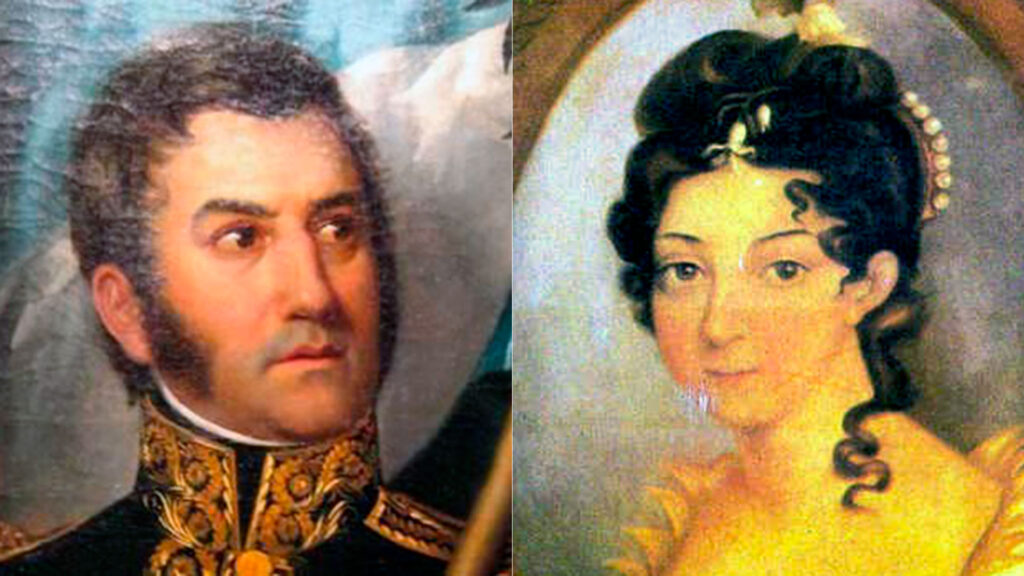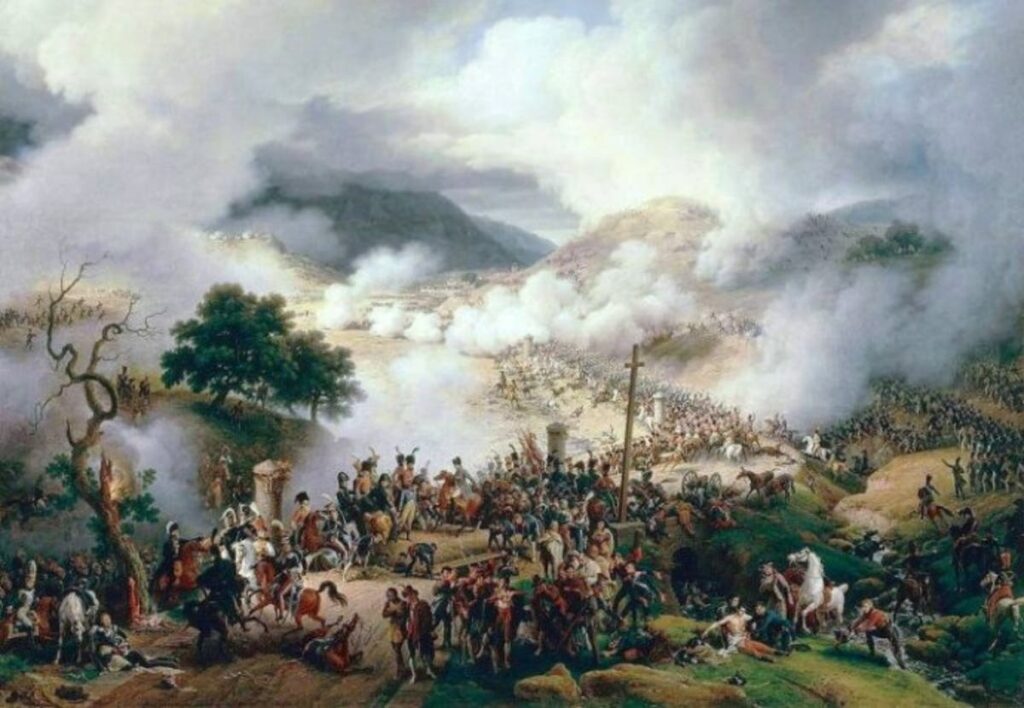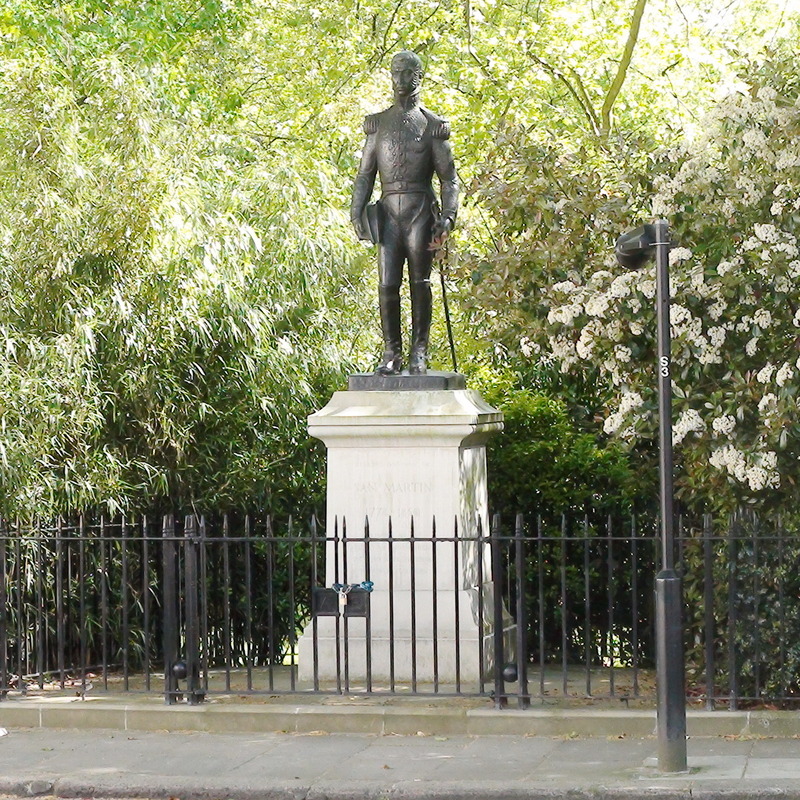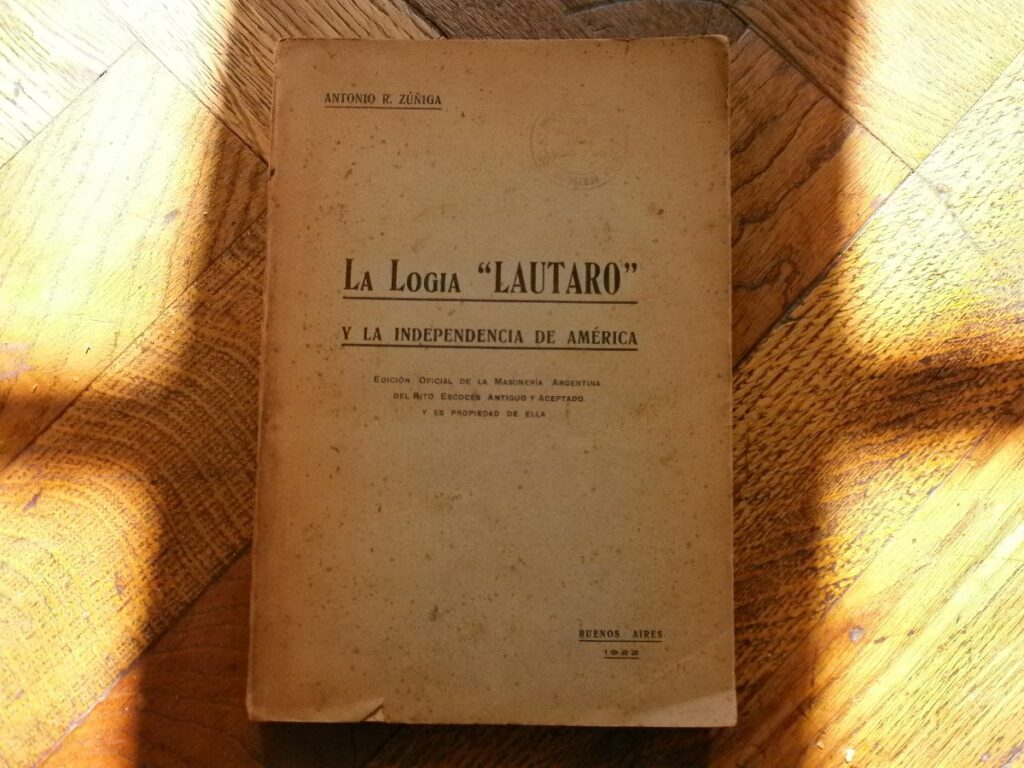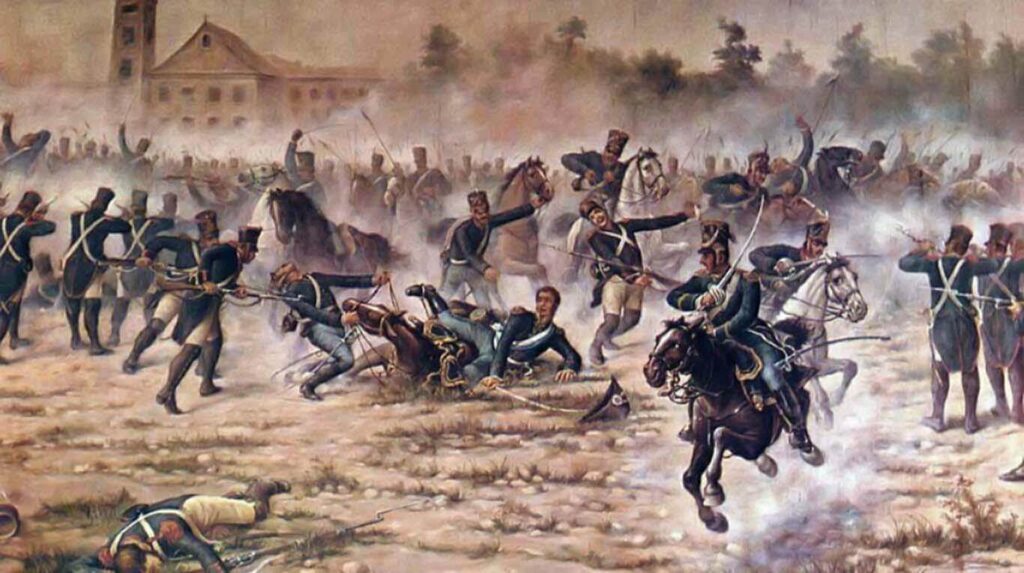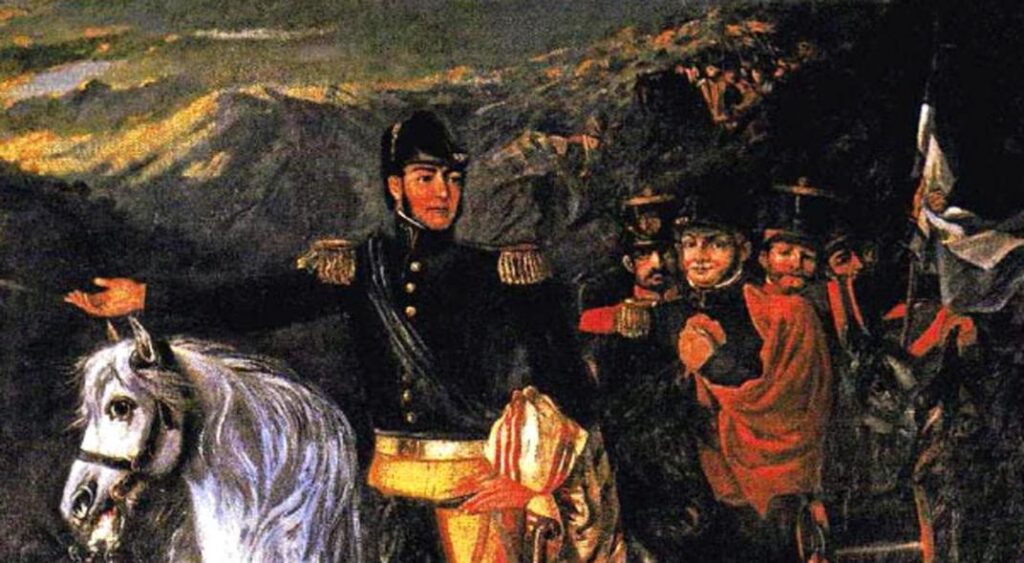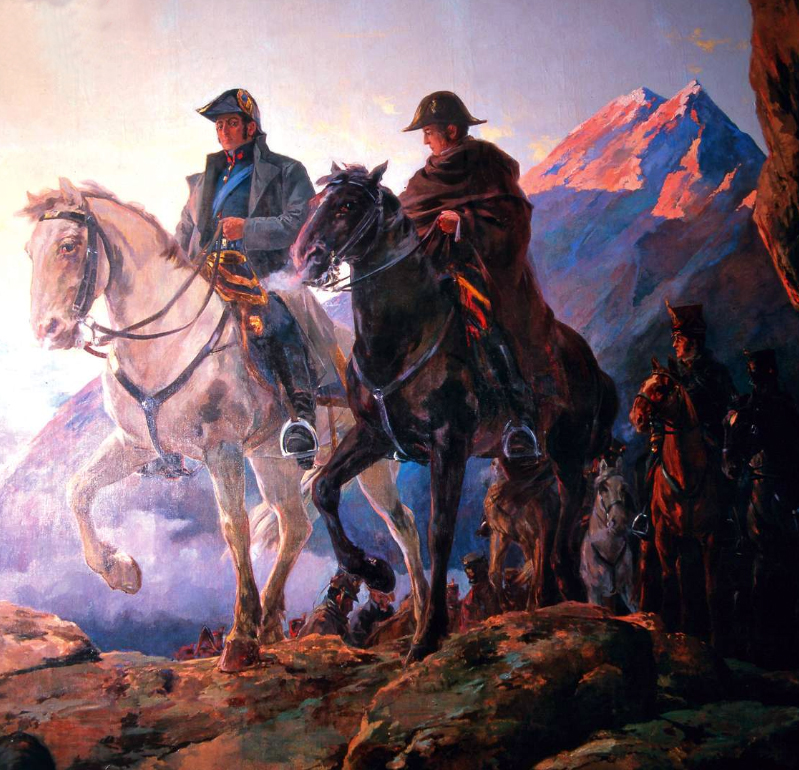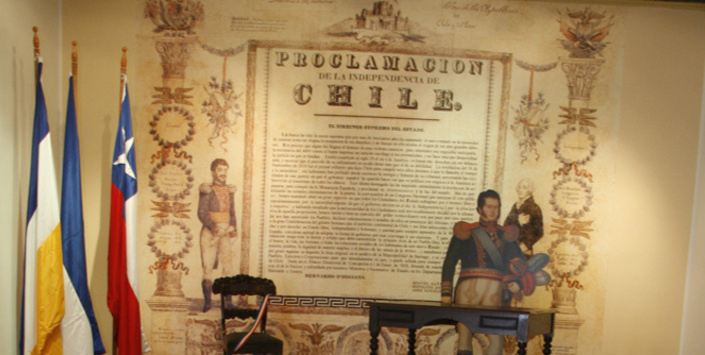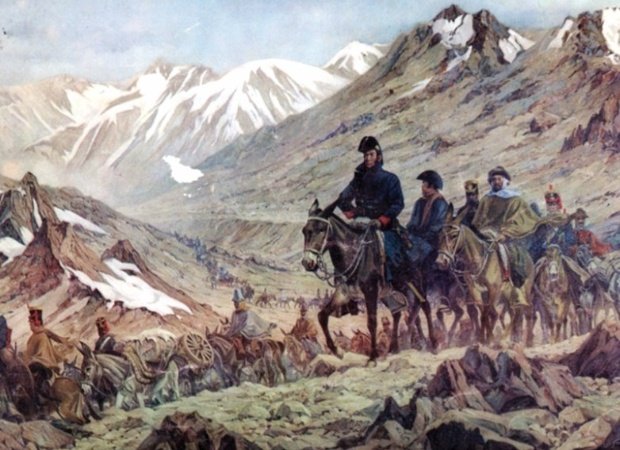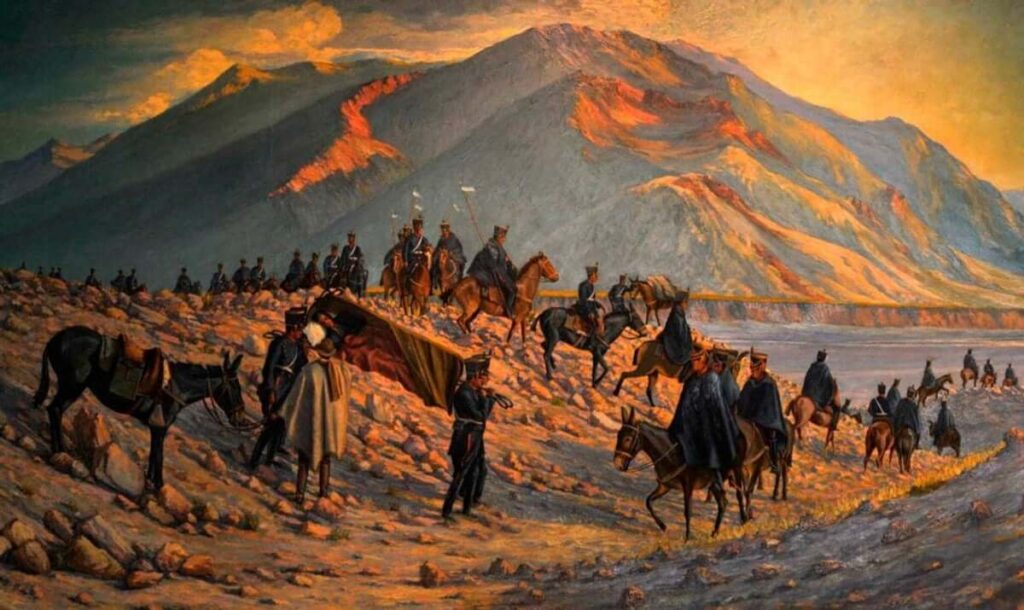Jose de San Martin, a man who was born with great ideals of struggle and freedom, carried out military studies achieving the liberation of several nations, among which Peru, Chile and Argentina are mentioned. It is an interesting story of a great hero, do not miss it.
Jose de San Martin: Family
José de San Martín, was born into a family made up of his parents Juan de San Martínez Gómez, who was born on February 3, 1728, in Cervatos de la Cueza, Palencia, Spain, who died on December 4, 1796 in Malaga Spain, at 68 years of age he was buried in the Recoleta Cemetery, Buenos Aires Argentina.
The father of José de San Martín, known as Juan de San Martín, was the son of Andrés de San Martín and Isidora Gómez, originally from the town of Cervatos de la Cueza, currently the province of Palencia, formerly the Kingdom of León in Spain, he was the department's lieutenant governor.
He served as a soldier to the Spanish Crown, and in 1774 he was appointed as governor of the Yapeyú Department, which is part of the Government of the Guaraní Missions, founded to manage the administration of the thirty Guaraní Jesuit missions, after the order was banished from America by instructions of Carlos III in the year 1767, based in Yapeyú.
Juan de San Martín married Gregoria Matorras by proxy, being represented in this legal act by the captain of dragoons named Juan Francisco de Somalo, being on October 1, 1770, but, with the blessing of Bishop Manuel Antonio de the Tower, in Buenos Aires.
Later, they traveled to Calera de las Vacas, today known as Calera de las Huérfanas in Uruguay, to take up the position of administrator of the Jesuit farm, where three of their children were born.
He was appointed lieutenant governor of Yapeyú, in the year 1775, his other children were also born in that place, José was the youngest of his children. Juan de San Martín planned and carried out the organization of the military corps of Guarani natives, made up of 500 men, who had the responsibility of defeating the progress of the Portuguese and the invasions of the Charrúa indigenous people.
In 1779, Juan de San Martín was promoted to the rank of captain of the royal army, after Gregoria Matorras returned to Buenos Aires with five children, meeting her husband in 1781. In the month of April 1784, Juan de San Martín and his family arrived in Cádiz.
Gregoria Matorras, due to the death of her husband, gave her a simple pension and lived with her daughter María Elena and her granddaughter Petronila. She died in Orense, Galicia, on June 1, 1813.
His mother Gregoria Matorras del Ser was born on March 12, 1738, in Paredes de Navas, Castilla, Spain, she was baptized on March 22, 1738, in Paredes de Navas, Castilla, Spain. She died on June 1, 1813, in Orense, Galicia, Spain at the age of 75.
Your grandparents, uncles and aunts
Among her paternal grandparents, uncles and aunts are: Andrés de San Martín y de la Riguera, and Micaela Baez; Andres de San Martin de la Riguera, Isidora Gomez. Among his maternal grandparents, uncles and aunts, mention is made of Domingo Matorras and González de Nava, and María del Ser Anton, Miguel Matorras del Ser, Domingo Matorras del Ser, Paula Matorras del Ser, Francisca Matorras del Ser, Ventura Matorras del Ser, Gregoria Matorras of Being.
Your brothers and sisters
His brothers and sisters include María Elena de San Martín y Matorras, married to Rafael González y Álvarez de Menchaca, his brother Manuel Tadeo de San Martín, married to Josefa Manuela Español de Alburu, and his brother Justo Rufino de San Martín y Matorras. , Juan Fermin of San Martin and Matorras.
While in Spain, all his brothers continued their military careers and barely communicated. But, José de San Martín communicated with his brothers through letters, in the same way his sister María Elena did.
Perhaps expatriate in Europe, San Martín had no news of his brother Juan Fermín, who had died in Manila and probably conceived two children; so it was assumed that the only descendant of all his brothers was Petronila González Menchaca, the daughter of María Elena.
On August 8, 1793, his brother Justo Rufino de San Martín asked to join the Spanish army and was accepted into the Royal Corps of Corps Guards on January 8, 1795. He was later incorporated into the Hussar Cavalry Regiment of Aragon, with the rank of captain. He participated in the War of Independence, as well as in significant events linked to it.
Once José de San Martín was exiled, his brother Justo accompanied him on many occasions on his trips to Brussels and Paris between 1824 and 1832. He died in 1832 in Madrid.
Others
His godfather at baptism, Mr. José Patricio Thomas Ramón Balcare Roca Mora.
Your marriage
He contracted marriage on September 12, 1812, in Buenos Aires, United Provinces of the Río de la Plata, with María de los Remedios de Escalada, with only 14 years of age, he was born on November 20, 1797, in Buenos Aires, Viceroyalty of the Río de la Plata, Spanish Empire, was baptized on November 21, 1797, in Buenos Aires, Viceroyalty of the Río de la Plata, Spanish Empire.
Daughter of Antonio José Escalada and Tomasa de la Quintana and Aoiz. She belonged to a rich and prestigious family, related to the patriot cause. Her family had great influence in founding the Horse Grenadier Regiment.
Then, established in Mendoza, Remedios de Escalada, was the creator of the Women's Patriotic League, in order to support the nascent Army of the Andes. She collaborating with the donation delivery of all her jewelry.
But before leaving for Europe in the year 1824, her husband contributed to the building of a pantheon in the La Recolecta Cemetery, and on her tombstone she inserted a writing that stated: "Here lies Remedios de Escalada, wife and friend of General San Martin"
She died on August 3, 1823, in Buenos Aires Argentina, when she was 25 years old, she was buried in the Recolecta Cemetery.
Manuel de Olazábal and Laureana Ferrari Salomón were present as witnesses to their marriage.
Their children
Their children Mercedes Tomasa de San Martín and Escalada, being the only daughter conceived by San Martín and his wife. She was born in Mendoza on August 24, 1836, and died in Brunoy, France, on February 28, 1875.
She was married to Mariano Antonio Severo González Balcarce Buchardo. Her grandchildren María Mercedes Balcarce and José de San Martín, Josefa Dominga Balcarce y San Martín, married to Eduardo María de los Dolores Gutiérrez de Estrada y Gómez de la Cortina.
In the year 1830, San Martín emigrated permanently to Paris, where he went with his daughter. Because of many revolutionary uprisings, the family decides to travel to a more distant town, known as Boulogne-sur-Mer.
Being in this place, they contract the cholera disease, while the Argentine doctor and diplomat named Marino Severo Balcarce, was in charge of giving them medical attention.
Finally, with the death of his father, as well as Balcarce's retirement from diplomacy, the family decided to move to Brunoy, near Paris. Mercedes, she dies in this place when she was 58 years old.
For the year 1951, her funeral remains, those of her husband and her eldest daughter, were repatriated and currently rest in the pantheon of the Basilica of San Francisco in Mendoza.
José de San Martín was born on November 25, 1778 in Yapeyú, a former mission located on the banks of the Uruguay River in the Government of the Guarani Missions of the Viceroyalty of Río de La Plata, in the well-known Argentine Province.
Being very young, he already showed interest in a military career and a leadership character, among his entertainments were war songs, voices of command.
stay in Europe
In the month of April 1784, at the age of six, he arrived with his family in the city of Cádiz, Spain, before they stayed in Buenos Aires, and later he settled in the city of Málaga.
He studied at the Royal Seminary of Nobles in Madrid, and also studied at the School of Temporalities in Malaga in 1786. In this house of studies, he learned different languages and arts such as: Spanish, Latin, French, German, dance, drawing , poetic literature, fencing, oratory, mathematics, history and geography.
Military career in the Spanish Army
For the date of July 21, 1789, when he was barely eleven years old, San Martín entered the Spanish army, carving out his military career in the Murcia Regiment, beginning as a cadet.
At the same time the French Revolution began. He participated in the fighting in North Africa, fighting the Moors at Milla and Orán, as well as against the Napoleonic battle of Spain, and fought against Bailén and La Albuera.
For the date of June 9, 1793, he was promoted to the rank of second lieutenant, because of his interventions in the Pyrenees, fighting the French. In the month of August of that year, his platoon, who had fought in the naval battles against the English fleet in the Mediterranean Sea, was defeated.
By July 28, 1794, he reached the rank of second lieutenant 1, by May 8, 1795 he reached the rank of lieutenant 2, and by December 26, 1802, he achieved the rank of assistant 2.
In the year 1802, he was surprised and severely injured by robbers while he was carrying the payment of the troops, which resulted in him being punished for this event. If you want to know more about history and important characters, we recommend reading the article Emiliano Zapata.
By November 2, 1804, he was promoted to the rank of captain. During this time, he fought with the rank of captain 2nd of light infantry, in many events, in the War of the Oranges against Portugal, being the year 1802, and in the year 1804 in Gibraltar and Cadiz against the British.
On August 11, 1808, he was awarded the Gold Medal of the Heroes of Bailén, a Spanish military award that is given to San Martín, by decree of the Supreme Board of Seville, in recognition of his great performance in the battle defeating the French, which is why he was also promoted to lieutenant colonel.
In the year 1808, the army of the French Emperor Napoleon Bonaparte attacked the Iberian Peninsula, while Fernando VII of Spain was captured. Soon after, the outbreak of the rebellion began against the emperor and his brother Joseph Bonaparte, who had been announced as king of Spain.
Immediately a Communal Governing Board was installed, acting first in Seville and later in the city of Cádiz. Then, San Martín was promoted by the Central Government Board to the rank of assistant 1st of the Campo Mayor Volunteer Regiment. Likewise, he rendered his services for a year to the war frigate Dorotea.
For his outstanding performances during the Spanish War of Independence against French troops, he was promoted to the rank of captain of the Bourbon Regiment. His most outstanding action was in the triumph of the battle of Bailén, an event on July 19, 1808, for his valuable action as assistant to General Marquis de Coupigny, in the event of Kneeling, which with the support of only twenty-one men , absolutely dominated a larger troop.
This triumph was the first significant defeat against Napoleon's army, allowing the Andalusian troops to rescue the city of Madrid. In recognition of his honorable event, San Martín was awarded the rank of lieutenant colonel on August 11, 1808. Likewise, the Gold Medal of the Heroes of Bailén was awarded to the entire army.
In this way he continued his battle against the troops that were under the command of Napoleon united in Roussillon, Portugal, England and Spain. During the battle of La Albuera, he fought under the command of the English general William Carr Beresford, who two years earlier, in the first English invasion, had tried unsuccessfully to take Buenos Aires and Montevideo.
It was during these battles that he met James Duff, a distinguished Scotsman who inducted him into the occult meetings plotting to gain South American independence. In this place, he first came into contact with the liberal and revolutionary groups that supported the battle for American independence. We invite you to know the interesting history of Victorian Orchard
San Martín intervened in 17 war events, such as: Plaza de Orán, Port Vendres, Batteries, Coliombré, war frigate Dorotea in a combat with the British ship El León, Torre Batera, Cruz de Yerro, Mauboles, San Margal, Batteries of Villalonga, Bañuelos, the Heights, Hermitage of San Luc, Arrecife de Arjonilla, battle of Bailén, combat of the Villa de Arjonilla and in battle of Albuera.
Then over time, in the year 1793, his troop became part of the Army of Aragon, immediately after that of Rosetón, who fought against the French Republic under the orders of General Ricardos, being one of the main Spanish generals, with more conditions, and who was a good mentor for the young cadet San Martín.
In 1794, when General Ricardos, known as the Murcia, died, the detachment to which he belonged surrendered to the French. In the year 1797, San Martín was baptized under fire at sea, because he was in Murcia, aboard the Spanish fleet that was fighting against the English in the Mediterranean, he also participated in the dispute of Cabo San Vicente .
During the years 1800 to 1807, San Martín participated in the Spanish events that were against Portugal, but, finally, by the Fontainebleau agreement of the city of France and Spain, Portugal and its different colonies were shared.
London
On May 25, 1810, the May Revolution took place in the city of Buenos Aires, which ended up deposing the viceroy, by the Viceroyalty of the Río de la Plata, and executing the appointment of the First Board.
During the independence process, new circumstances of a military nature were opened for the benefit of the South American military, including José de San Martín, and demanding a modification of what was absolute loyalty, because their native homeland was not within the Kingdom of Spain, where it had emerged.
On September 6, 1811, San Martín renounced his military career in Spain, leaving all his struggle behind, and asked the leader to grant him a passport to travel to London. What was granted, as well as letters of recommendation, one addressed to Lord Macduff, traveling on September 14 of that same year, to settle in Park Road, number 23 in the district of Westminster.
While in this place he met Carlos María de Alvear, José Matías Zapiola, Andrés Bello and Tomás Guido, and many other of his companions.
Certain experts in the field of history say that they were part of the group of the Great American Reunion, a society that supposedly had Masonic origins, which was created by Francisco de Miranda, who along with Simón Bolívar, who was already fighting for in America for the independence of Venezuela.
Probably within the brotherhood, there were British political links that made known the Maitland Plan, a tactic for America to be liberated from Spain.
Return to the River Plate
He returns to Buenos Aires and recognition of his rank of lieutenant colonel by the First Triumvirate
In the year 1812, at the age of 34, with the rank of lieutenant colonel, and after a stopover in London, moving on the British frigate George Canning, he returned to the city of Buenos Aires, to surrender to the service of the independence of the United Provinces of the Río de la Plata.
The officers presented themselves to the members of the First Triumvirate, who accepted him to provide their services to the government.
Creation of the Horse Grenadier Regiment
On March 16, the First Triumvirate admits the proposition put forward by José de San Martín to form a cavalry corps, for which he was commissioned to found the Regiment of Grenadiers on Horseback, to safeguard the coasts of the Paraná River. In the year 1812, he dedicated himself to teaching the regiments in innovative battle techniques, which he had from his European experience while fighting Napoleon's armies.
Foundation of the Lautaro Lodge
In the company of Carlos María de Alvear, who had recently returned, he created in the middle of 1812 an agency of the Lodge of Rational Knights, which was renamed Lodge Lautaro.
The name originates from Mapuche lonko Lautaro, who was a prominent Mapuche military leader in the Arauco War during the first phase of the Spanish conquest, and who in the XNUMXth century rose up against the Spanish.
The foundation was composed like the Cadiz and London Masonic lodges, similar to those that existed at that time in Venezuela, as main members Francisco de Miranda, Simón Bolívar and Andrés Bello.
Its main function was "to work with a system and plan for the independence of America and its happiness." Among its main members, there were also San Martín and Alvear, they were José Matías Zapiola, Bernardo Monteagudo and Juan Martín de Pueyrredón.
Revolution of October 8, 1812
In the month of October of the year 1812, in Buenos Aires the information of the patriotic triumph of the Army of the north in the battle of Tucumán, which was governed by General Manuel Belgrano, is spread. On October 8, they took advantage of the event, so José de San Martín y Alvear led a civic-military uprising instructed by the Lautaro Lodge, popularly known as the revolution of October 8, 1812.
The conflict ended with the dismissal of the government of the First Triumvirate, who was seen as "little decided by independence."
Finding themselves pressured by the armed forces and the people, a Second Triumvirate was appointed, formed by Juan José Paso, Nicolás Rodríguez Peña and Antonio Álvarez Jonte. In the same way, it was required to call a General Assembly of delegates belonging to all the provinces, with the purpose of declaring independence and pronouncing a new constitution.
In December 1812, the Second Triumvirate promoted San Martín to the rank of colonel and appointed him Commander of Horse Grenadiers based on the three squadrons that already existed.
Combat of San Lorenzo
The story goes that the first military event in San Martín, together with its recently formed Regiment of Grenadiers on Horseback, was led to stop the irruptions with which the royalists of Montevideo devastated the coasts of the Paraná River, the most important tributary being the Río de la Plata, and a communication route necessary for the area.
Then, Colonel José de San Martín, along with his troops, settled in the convent of San Carlos, on the way to San Lorenzo in the south, currently the province of Santa Fe. In the month of February 1813, and due to the arrival of 300 royalists, the battle of San Lorenzo was fought, on the banks of the river and close to the front of the convent.
Because there were strong doubts about his loyalty to the independence cause, given the recent arrival of San Martín, he resolved to continue leading the small army of horse grenadiers.
So his horse was seriously injured and San Martin was crushed under the animal, while he was about to be killed by a royalist. But, due to the intervention of a soldier from Corrientes named Juan Bautista Cabral, who placed his body to be wounded at the point of a bayonet.
This soldier was promoted after the death of José de San Martín, for this reason he is known as Sergeant Cabral. It was a battle, where the two troops had a large number of combatants, showing itself as a secondary event, however, it managed to separate forever the royalist troops that crossed the Paraná River, assaulting the neighboring towns.
Chief of the Northern Army
Because of the defeats that Manuel Belgrano, general in chief of the Army of the North, suffered facing the royalists in the Vilcapugio and Ayohúma contests, and because of the victory in the fight of San Lorenzo, the so-called Second Triumvirate supplanted Belgrano by San Martín as the commander of the Army of the North.
In his meeting with the outgoing leader, whom he did not know in person, it has been described as the "Yatasto hug", because custom has agreed on it at the Yasto cavalry house, located in the province of Salta.
According to the investigations carried out by the scholar Julio Arturo Benencia, he affirms that the meeting took place on February 17, 1814, at the exit of the Algarrobos post, near the Juramento river and at a distance of 14 leagues from Yatasto.
Acting as commander of the Auxiliary Army of Peru, he must have reestablished an army that was helpless due to the domains of Vilcapugio and Ayohúma. With the intention of clarifying the fact, he returned to San Miguel de Tucumán, where he camped the army in a fort that was under construction, which is called Ciudadela, while he resolved to make it strong and give it training in an applied way.
Its creation was crystallized with the battle of San Lorenzo. Later, he was assigned the responsibility of the leadership of the Army of the North, replacing General Manuel Belgrano.
In this management, he was able to achieve his continental plan, knowing that the patriot victory in the Spanish-American war of independence would only be achieved with the devastation of all royalist groups, being the main loyal centers of power that maintained the colonial system in America.
Continental Plan
A few days after being established in Tucumán, San Miguel, determined that it was inaccessible to travel via Alto Perú to the city of Lima, capital of the Viceroyalty of Peru and center of royalist power in South America. Place where invasions were sent with the purpose of taking the helpless territories before the independentistas.
Every time a royalist army came from the Altiplano bound for the valleys of the province of Salta, it was surely defeated, just as when the patriot army arrived in Upper Peru, it was also defeated.
The cause of having an advantageous tactic to the upper Peruvian route, had been previously alerted by certain military leaders who were part of the campaigns to Upper Peru, among which were: Eustoquio Díaz Vélez, Tomás Guido and Enrique Paillardell.
José de San Martín, an expert and military strategist, quickly grasped this idea as his own and executed his continental plan.
From then on, the general carried out his project of crossing the Andes Mountains and assaulting the city of Lima from the Pacific Ocean. Seeking to keep the northern border secure, San Martín took care of the irregular troops from Salta, who were under the command of Colonel Martín Miguel de Güemes, to whom he assigned the responsibility of protecting the northern border, and began the preparation of his next military strategy.
For a short time, he entrusted him with the command of the Army of the North in the hands of General Francisco Fernández de la Cruz, retiring to Saldán, province of Córdoba, with the purpose of undergoing medical treatment for a stomach ulcer.
While he was in this place, he was in constant talks with his friend named Tomás Guido, who convinced him that it was necessary to make the territory independent from Chile.
Governor of Whose
In the year 1814, the Supreme Director of the United Provinces of the Río de la Plata, named Gervasio Antonio de Posadas, appointed as governor of the Cuyo region, in the city of Mendoza, Argentina, he carried out his project, after constitute the Army of the Andes, crossed the entire mountain range that bears the same name, being the leader of the emancipation of Chile during the struggles of Chacabuco and Maipú.
Positioning in Chilean politics
After some time, and after taking care of his activities, the colonel named Juan Gregorio de Las Heras arrived, who had started in the Argentine forces in Chile, and also retired due to disagreements with the Chilean patriots.
He decided to return it with the intention of supporting them against the royalist troops, but this came after the Rancagua Disaster, where they lost Chilean independence. The only thing he managed to do was save the crossing to Mendoza from many Chilean refugees.
The Chileans were fragmented into two incompatible groups, being: the conservatives who were under the order of Bernardo O'Higgins, and the liberals who were under the control of José Miguel Carrera.
Then José de San Martín decided that they should go ahead quickly, so he decided on O'Higgins. After pretending to disregard the authority of the governor of Cuyo, General Carrera was imprisoned, removed from his command, and later evicted from Mendoza.
The purpose of José de San Martín's plan, which he thought was to implement it from a totally patriotic Chile; however, due to the taking of this nation in opposing hands, the plan looked like it should be eliminated. Although, San Martín decided to continue advancing, but with the intention that he first had the duty to liberate Chile.
Creation of the Army of the Andes
Although there has been resistance from the new supreme director, Carlos María de Alvear, whom San Martín had the opportunity to meet in Cádiz, and also accompanied him, and proposed to order the Army of the Andes.
He brought together in a single army all the Chilean refugees, the local militias from Cuyo, many of the volunteers from his province, and some officers from the Army of the North. Likewise, he requested and obtained that the groups of the Horse Grenadier Regiment, who were scattered everywhere, were all reunited in Cuyo.
Seeing that Alvear tried to subjugate him under his authority, he immediately submitted his resignation to the position he held as governor. Then, Alvear immediately placed Colonel Gregorio Perdriel as his replacement, however, he was rejected by all of the people of Mendoza. Thus, San Martín was appointed as governor by popular election.
Shortly after, after the appointment of General Juan Martín de Pueyrredón as the new supreme director, they held a meeting in Córdoba, as the main point they discussed the issue of the campaign plan regarding Chile and Peru.
Arriving on the date of May 20, 1816, Tomás Guido, presented the official report, where he showed the plan in detail, which was approved and given the order to execute by orders of director Pueyrredón.
At that time, José de San Martín influenced the Cuyo deputies to the Tucumán Congress to declare the independence of the United Provinces of South America, which he achieved on July 9, 1816.
In order to finance his campaign, as well as the numerous contributions of Pueyrredón, he demanded that they pay "mandatory contributions" to all merchants and owners of haciendas. As an exchange, they were given a voucher, which they could collect "when circumstances allowed it."
While, he had few considerations to seize the assets belonging to the Spaniards who will not support the cause of independence.
He came to found a large military camp in El Plumerillo, with a distance of approximately seven kilometers northeast of the city of Mendoza. In this territory, he trained all his soldiers and officers, managed to manufacture weapons such as: rifles, sabers, cannons, uniforms, ammunition and even gunpowder. He dedicated himself to fattening animals such as mules, horses, and making the proper horseshoes.
The leader of its workshops, the monk Luis Beltrán, was ingenious in inventing a system of pulleys that allowed the passage of the ravines with the cannons and any type of suspension bridge could be transported.
The medical part of the army was in charge of the English surgeon James Paroissien. While Colonel José Antonio Álvarez Condarco, he was in charge of preparing the plans of the different crossings of the Andes Mountains.
Before starting the tour, together with all the Mapuche chiefs, he requested authorization to enter Chile through its territories. While certain of these caciques informed the captain general of Chile, named Casimiro Marco del Pont, then he came to think that the strong attack would be committed from the south, so he fragmented his forces.
Contrary to what was imagined by the supreme director Pueyrredón, together with his followers, he entered into communication with the caudillo named José Gervasio Artigas, as he refused to entertain his battle effort of the emancipatory campaigns in Chile and Peru, which would allow them to confront the federals on the coast of the Río de la Plata.
This was the reason why the unit directors, especially Bernardino Rivadavia, declared him a traitor.
In a letter dated August 1816, San Martín refers to the Malvinas Islands. In its content, San Martín, requested the governor of San Juan, who will release the prisoners who were in Carmen de Patagones and Malvinas, Puerto de Soledad, so that they will join the Army of the Andes.
Liberating expedition to Chile
On January 1817, the journey to cross the Andes to Chile began. The Army of the Andes was considered one of the largest military contingents that the United Provinces of the Río de Plata dispersed in the Spanish-American War of Independence. In its beginnings it had three brigadiers, twenty-eight chiefs, two hundred seven officers, and three thousand seven hundred seventy-eight soldiers.
They contained part of the Chilean officers and soldiers who emigrated to Mendoza, after the Rancagua conflict.
Many writers of Chilean origin, such as Osvaldo Silva and Agustín Toro Dávila, refer to a large number of Chilean patriots, however, none of them mention in detail the documentary source they used in such assertion.
While Osvaldo Silva in his text Atlas de la Historia de Chile 2005 maintains that there were one thousand two hundred Chileans in the Army of the Andes who were agglomerated in Mendoza. And Agustín Toro Dávila, in his text Military Historical Synthesis of Chile, mentions a similar amount.
For what author textual plasma:
Of the 209 crew officers, around 50 were Chilean, and the rest Argentine. The proportion of Chileans in the 3778 troops is not exactly known. It is estimated that it would not be more than 30%.
In order to fragment the opposing troops, San Martín authorized the progress of part of the troops through the passes of Come Caballos, Guana, Portillo and Planchón. Being the preferred steps as main buttresses, because the first two were to the north and the last to the south.
It was an advance of certain sectors in a front of more than 2000 kilometers through the passage of a huge mountain range. Action with which they tried to deceive the royalist forces of Chile, who had no knowledge of where they came from, forcing them to fragment their forces and in turn generate movements that favored the revolution in territories distant from the capital, Santiago de Chile.
Among which was the one led by Ramón Freire bound for Chillán, arriving a few days before, ahead of the others, and convincing the royalist governor that it would start in the south.
Finally, José de San Martin concluded his military career after having an interview in Guayaquil with Simón Bolívar, in 1822, in which he handed over his army and the achievement of the liberation of Peru.
Retirement
José de San Martin decided to withdraw when he considered that he had fulfilled his duty to liberate the peoples. In the month of October of the year 1822 he arrived in Chile and in the summer of the year 1823 he crossed the Andes, passing through Mendoza, with thoughts of settling in this region so that he would be out of public life.
However, due to many negative comments that accused him of having leadership aspirations, as well as the death of his wife in February, led him to take Europe as his destination, accompanied by his daughter Mercedes, who He was only seven years old at the time.
He lived for a time in Great Britain, and then went to Brussels, Belgium, where he lived modestly; due to his meager income, he only had to pay for Mercedes' studies.
For the year 1827, his health is broken, because of rheumatism and its economic part: the income was barely enough for his food. In those years that he was in Europe, he felt a strong nostalgia for his native country.
His last attempt to return was carried out in 1829, two years prior, he offered his services to the Argentine authorities, and with his war experience to face the Brazilian Empire. At this time, he headed to Buenos Aires, in order to reconcile in the destructive trance that the federals and centralists maintained.
But, upon arrival, what he found was his homeland in a state of disintegration due to the violent battles that his intention abandoned, despite the request of many friends, it did not lead him to set foot on his long-awaited Argentine coast.
He returned to Belgium and in 1831 he passed through Paris, where he lived next to the Seine, in a Grand-Bourg estate, for which he thanks his generous friend Don Alejandro Aguado, who was his comrade-in-arms in Spain. In the year 1848, he established his permanent residence in Boulogne-sur-Mer, France, his life ending due to his death on August 17, 1850, at the age of 72. . He was buried in the Cathedral of Buenos Aires, on May 28, 1880.
José de San Martín and Simón Bolívar, are considered the two greatest liberators of South America in the Spanish colonization.
In Argentina he is considered the father of the Nation, he is paid representative tributes and he is valued as the main hero and hero of the nation. In Peru, he is recognized as the liberator of the nation, granting him the titles of "Founder of the Freedom of Peru", "Founder of the Republic", and "Generalissimo of Arms". The Chilean Army recognizes him with the rank of Captain General.


